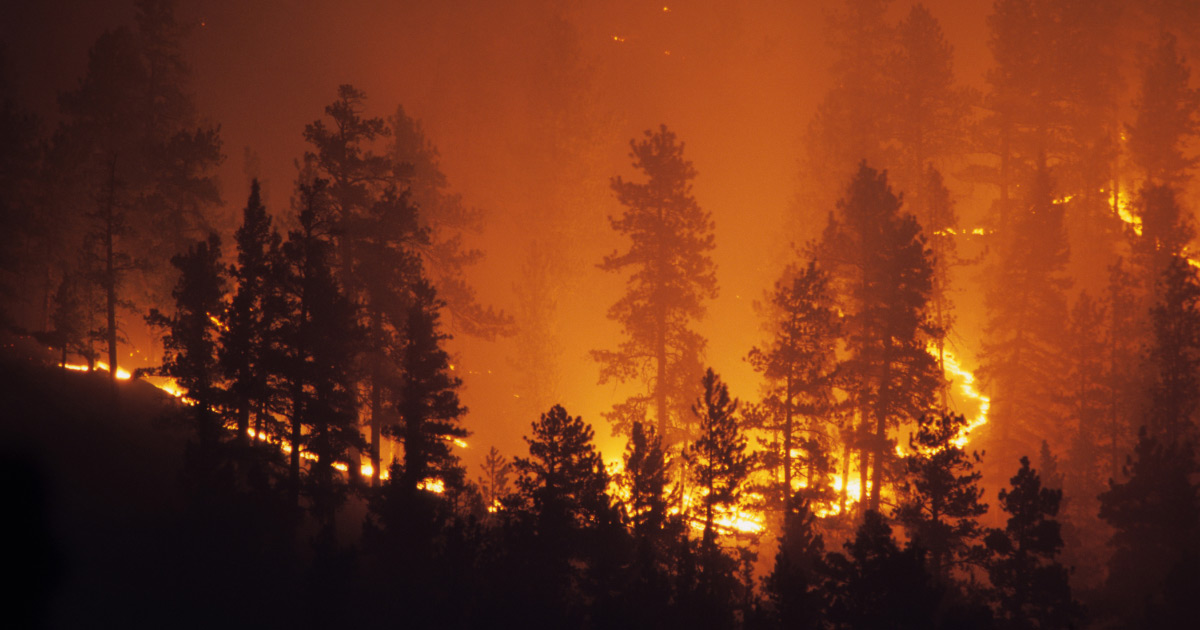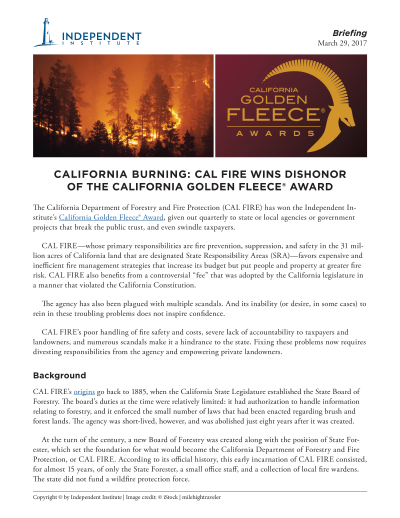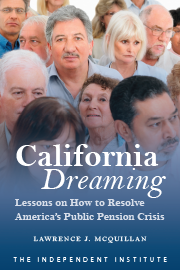The California Department of Forestry and Fire Protection (CAL FIRE) has won the Independent Institute’s California Golden Fleece® Award, given out quarterly to state or local agencies or government projects that break the public trust, and even swindle taxpayers.
CAL FIRE—whose primary responsibilities are fire prevention, suppression, and safety in the 31 million acres of California land that are designated State Responsibility Areas (SRA)—favors expensive and inefficient fire management strategies that increase its budget but put people and property at greater fire risk. CAL FIRE also benefits from a controversial “fee” that was adopted by the California legislature in a manner that violated the California Constitution.
The agency has also been plagued with multiple scandals. And its inability (or desire, in some cases) to rein in these troubling problems does not inspire confidence.
CAL FIRE’s poor handling of fire safety and costs, severe lack of accountability to taxpayers and landowners, and numerous scandals make it a hindrance to the state. Fixing these problems now requires divesting responsibilities from the agency and empowering private landowners.
Background
CAL FIRE’s origins go back to 1885, when the California State Legislature established the State Board of Forestry. The board’s duties at the time were relatively limited: it had authorization to handle information relating to forestry, and it enforced the small number of laws that had been enacted regarding brush and forest lands. The agency was short-lived, however, and was abolished just eight years after it was created.
At the turn of the century, a new Board of Forestry was created along with the position of State Forester, which set the foundation for what would become the California Department of Forestry and Fire Protection, or CAL FIRE. According to its official history, this early incarnation of CAL FIRE consisted, for almost 15 years, of only the State Forester, a small office staff, and a collection of local fire wardens. The state did not fund a wildfire protection force.
That began to change in 1919, when the state began to allocate money for fire prevention and suppression, CAL FIRE’s current mandate. In the years that followed, the agency’s budget grew, along with its personnel and jurisdiction. Today, CAL FIRE assumes the primary responsibilities of fire prevention, suppression, and safety in the areas that are designated the State Responsibility Area (SRA).
The SRA is the land for which the State of California has primary financial responsibility when it comes to wildfire management. In total, it covers more than 31 million acres, and includes land that is privately owned, state owned, watershed, and rangeland. It excludes federally owned land, as well as land that falls within city boundaries.
In recent years, CAL FIRE has been charged with a tremendously important task, as drought and a beetle infestation have increased dead trees and raised fire risks in the state, and numerous wildfires have ravaged property and taken lives. Even this winter’s heavy rainfall could increase future fire risks in some parts of California as rain gives life to new vegetation thus generating extra fuel for burning during future fire seasons. Given these conditions, CAL FIRE’s failures have become more apparent and the need for change more urgent.
CAL FIRE Gets Failing Grade: Misguided Priorities, Poor Performance, and Increasing Budgets
CAL FIRE is the state’s second-largest recipient of budget funds among resource departments, behind only the Department of Water Resources. As the California Legislative Analyst’s Office reports in its breakdown of the proposed 2016–17 fiscal year budget, CAL FIRE stands to receive nearly $2.2 billion— an increase of almost 12 percent over the estimated budget for the previous year, and a 42 percent increase over its allocation for the 2014–15 fiscal year. Of this, about $1.8 billion is allocated toward fighting fires. The agency has become increasingly expensive for California taxpayers, a product of its misguided priorities.
CAL FIRE’s priority has been fire suppression, rather than prevention, and the budget bears this out. The proposed allocation to the SRA Fire Prevention Fund (SRAFPF)—which pays for efforts to reduce hazardous fuels (like dead trees and vegetation), provide fire prevention education, and plan fire prevention—is 5 percent smaller than estimated for the previous year. Of the $76 million proposed to the SRAFPF, only about $16 million are being made available in grants for local fire-prevention efforts.
Why the neglect for fire prevention? Ryan Yonk, a research fellow at the Independent Institute, and Devin Stein, a research associate at Strata Policy, explain that fire managers “face an incentive to focus on suppression where the budgets are larger, the risks are lower, and the very act of suppressing wildfires is much more heroic than chopping dead trees and conducting prescribed burns.” This problem plagues CAL FIRE as well as the U.S. Forest Service. This incentive has taken a heavy toll on fire prevention, which has proven to be superior to fire suppression at containing costs and damage once a major fire begins. Just consider the destruction wreaked on California in 2016.
CAL FIRE reports that in 2016 there were 5,762 wildfires in the SRA and contracted Local Responsibility Area, about 600 fires more than in 2015 and about one thousand more fires than the five-year annual average. Collectively they burned nearly 150,000 acres. This follows the very destructive fires of 2015, which burned 307,598 acres and brought the third most damaging wildfire in the state’s recorded history, the Valley Fire, which burned more than 75,000 acres of land in Lake, Napa, and Sonoma Counties, destroyed nearly 2,000 structures, and took four lives.
It is troubling, given these outcomes, that CAL FIRE’s priority remains fire suppression rather than prevention. The costs associated with fighting fires are high and have varied greatly, especially over the past 10 fiscal years. The 2010–11 fiscal year, for example, saw $90 million in suppression expenditures, whereas expenditures in the 2007–08 fiscal year were nearly six times that amount ($524 million). Fire suppression remains a costly priority for the state, the lack of glamor associated with prevention notwithstanding.
Who is tasked with clearing brush and creating fire-containment lines?
Nearly all firefighters tasked with this job are extremely low-paid volunteer prisoners from state and select county jails, working as part of the California Department of Corrections and Rehabilitation Conservation Camp program (“Fire Camp”). For their work, they typically get paid $2 per day and receive “time served” credit of up to two additional days per day worked. Pay gets bumped up to $2 per hour when fighting a fire. In 2015, up to 40 percent of firefighters battling California wildfires were inmates. But, even though these fire camps provide cheap fire-prevention labor for CAL FIRE, in recent years even this has proven unsustainable.
The 2011 “realignment” mandate (Assembly Bill [AB] 109 and AB 117), which sought to reduce the state prison population by moving “low-level” prisoners to county jails, has reduced the number of prisoners eligible for Fire Camp. About one-tenth of the budgeted positions for inmates have remained unfilled each year. In order to make up for the shortfall, CAL FIRE has turned to the much-higher-paid civilian workers from the California Conservation Corps (CCC) to do what work they can, given their minimal training and experience
Regarding the use of CCC workers to replace inmates, CAL FIRE spokesman Daniel Berlant told the Los Angeles Times: “In our eyes there’s no difference in the work force.” One notable difference, however, is that civilian workers must legally be paid at least five times more per hour of labor as most inmate fire workers make in an entire day, all for the same unglamorous work that CAL FIRE continues to deprioritize.
CAL FIRE’s increasing neglect of fire prevention has been costly and disastrous for Californians.
CAL FIRE’s Unconstitutional $100 Million Annual “Fee”
In order to help fund fire-management operations, in 2011 California Governor Jerry Brown approved a controversial “fee” on hundreds of thousands of property owners within the SRA. The formal cost to property owners is approximately $117 to $152 per year for each habitable structure, depending on whether or not it also falls within the boundaries of a local fire-protection agency. But the actual costs are much greater, and they affect more than 800,000 Californians who are responsible for payment.
The bill that established this revenue source (AB 29) passed in both the California State Assembly and Senate with no Republican support and with almost all Democrats in support. Importantly, it also failed to reach the two-thirds vote in each house of the legislature as required by the state constitution to approve new taxes or tax increases. By calling it a fee, proponents were able to deceptively overcome this important hurdle that would otherwise protect California taxpayers.
In 2012, the Howard Jarvis Taxpayers Association filed a class action lawsuit, challenging the validity of the “fee” and seeking a refund for all money paid. The purported fee, it argued, fits the exact definition of a tax as outlined in the constitution, and fails to meet any of the criteria that would exempt it from the twothirds legislative vote requirement. Specifically, they noted that money collected is uniform in amount (despite a large diversity in the character and use of taxed structures, as well as their fire risk and required fire services), and it provides a benefit to the public at large—making the purported fee “neither service-based nor proportional as required for a levy to be deemed an exempt ‘fee’ rather than a ‘tax.’”
The association’s filing notes that even Governor Brown seemed to question the bill’s constitutionality when he signed it, by directing the Department of Finance and CAL FIRE to work with the legislature to “identify necessary clean-up language to realize these revenues.” Since that time no such language clarifying the bill has been passed. Nevertheless, in the summer of 2012 the State Board of Equalization began collecting revenue for the 2011–12 fiscal year. And each year since then, the state has collected nearly $100 million from the tax.
Oddly, much of the money has been kept in reserves rather than being spent for prevention operations. A report by the Sacramento Bee in October of 2015 found that roughly 14 percent of revenue collected by then (about $43 million) sat in unused reserves. One supporter of the tax, Democratic Senator Darrell Steinberg, expressed his concern over the large reserve: “I just don’t want money sitting there when there’s a lot of prevention to be had and an increase in the number of fires. . . . You spend the reserves during the most crucial times.”
Of the revenue spent, nearly 10 percent (approximately $22 million) went to covering tax collection costs. Meanwhile, less than half that amount ($9.5 million) was made available for local grants, leaving many fire prevention projects in vulnerable areas unfunded. As the Bee’s report noted, these included projects “to remove flammable vegetation and dead trees from around the homes of low-income senior citizens and disabled residents.” In some cases where funds were approved, such as a Lake County project to create a second evacuation route, they were made available after fires had begun. Along with legal problems and revenue misallocation, the “fee” has caused perhaps an even worse problem: it has prevented local agencies from independently raising money for their own much needed fire-prevention efforts.
As of this writing (March 2017), plaintiffs in the lawsuit are waiting for the court to schedule a trial date. But even before a formal legal discovery process is completed, key facts about the so-called fee are clear. It was not approved in accordance with the California Constitution, and it has been especially costly for the communities that need fire prevention most.
Another Day, Another Scandal for CAL FIRE
CAL FIRE’s problems do not end with its poor operational performance, unsound budget priorities, or unconstitutional tax. The agency is also plagued by a culture of corruption and scandal, which slowly revealed itself after the brutal murder of 26-year-old Sarah Douglas in 2014 by her boyfriend, CAL FIRE battalion chief Orville “Moe” Fleming.
In the early hours of May 1, Douglas and Fleming got into an argument after Douglas came home from an evening at a local casino with her mother and sister. Fleming, who was 31 years older than Douglas, had been described as a jealous and controlling boyfriend. That particular night he was so enraged at Douglas—who had been preparing to leave him, according to family members—that he stabbed her to death and strangled her with a bed sheet. Douglas’s sister, who had been on the phone with Douglas when the argument began, discovered the gruesome murder scene the next day and alerted police. Fleming, meanwhile, went into hiding for the next 16 days.
Police eventually found Fleming, and upon arrest he confessed to the killing. Although he was ultimately found guilty of second-degree murder and sentenced to 16-years-to-life in a state prison, the drama did not end there. An investigation into the murder and Fleming’s relationship with Douglas led to the discovery of a web of corruption and abuse plaguing CAL FIRE and its firefighting academy in Ione, near Sacramento.
When police interviewed Fleming’s estranged wife, she told them that she had seen a video of Douglas having sex with other firefighters at the CAL FIRE Ione academy. Douglas, in fact, had previously worked as a prostitute and met Orville Fleming through a website advertising sexual services. Although the police did not find any evidence that would confirm the existence of such a video, what they found implicated numerous others. The nearly $2 million investigation revealed scandal after scandal.
Investigators discovered that at least one high-ranking official, CAL FIRE Assistant Chief Scott A. Henry, routinely used his work-issued cell phone and vehicle to connect and meet with prostitutes. Rather than terminate him, CAL FIRE retained Henry as an employee but demoted him to the role of battalion chief.
It was also discovered that another CAL FIRE employee, fire apparatus engineer Timothy L. Edgmon, was accused of drinking alcohol at a cadet graduation ceremony—in violation of official department policy—where he made unwanted graphic sexual advances on a woman, including publicly exposing his genitals and making thrusting gestures toward her. Edgmon maintained that it was a joke, but he was eventually fired in connection with the incident.
Another employee, fire captain Cole Pereira, similarly violated rules on drinking at least three times at department events, and allowed cadets to do the same, but was only temporarily demoted to the role of fire apparatus engineer.
Then came the revelation of a test cheating scandal at the Ione academy.
According to multiple sources, unethical measures were taken to ensure that cadets passed their exams— including manipulating scoring, tossing questions that too many cadets missed, and providing actual test questions and answers at Sunday-night “review” sessions the night before exams. The sharing of test materials is, of course, a violation of the cadet handbook, but according to former cadets the practice was widespread and well known.
The systematic cheating on basic skills tests meant that some firefighters could have been ill-prepared for their jobs, especially initially, putting themselves and the public at greater risk.
A 2015 state investigation into the cheating has also revealed suspect promotional practices and “inconsistent and contradictory” recordkeeping that obscures the reasons why firefighters punished for cheating were able to quickly regain their former rank.
California taxpayers deserve better conduct than this for their money.
The Pathologies of Government: A Lesson in the Economic and Human Costs of Government Bureaucracy
The problems with CAL FIRE are multifaceted, but they all stem from an over-reliance on government to solve problems better handled locally and by private citizens, where oversight would be stricter.
Consider the answer put forward by Governor Brown to clean up the Ione academy: $4 million to create a new unit focused on improving professional standards. This approach has taken the form of more paperwork and another bureaucratic layer to re-emphasize the principles and guidelines already in the existing CAL FIRE handbooks, its mission statement, and the agency’s code of conduct.
As Sacramento Bee reporter Jon Ortiz expressed in reaction to CAL FIRE’s approach to reform, “This is what state government does. It documents and trains and reminds, then trains and reminds and documents some more. It assumes that personnel problems stem from ignorance, not character.” CAL FIRE needs to clean house, but instead it will have more bureaucratic hires, staff meetings, and employee manuals on the horizon.
Ultimately, it should come as no surprise that CAL FIRE is unable to set proper operational priorities and contain costs, and has had to rely on a deceptive funding source. Many similar problems exist with the U.S. Forest Service, which handles fire prevention and suppression on federal lands.
A July 2016 report by the U.S. Department of Agriculture Office of the Inspector General paints a bleak picture of the U.S. Forest Service’s hazardous fuels reduction program. It found, among other problems, that the agency “lacks a consistent, cross-agency process for selecting its highest priority hazardous fuels reduction projects for completion,” that its method for tracking accomplishments led it to inaccurately report information to Congress, and that work hours charged by some units may not have actually been performed. Many of these same problems appeared in a 2006 audit, to no apparent effect.
Government firefighting agencies, both federal and state, have performed poorly. In each case, the priorities for government agencies are different than those of the citizens whose lives, money, and property are at stake.
The Recommendations: Local Control, Private Ownership, and Accountability
Fixing CAL FIRE’s problems requires a bolder approach than merely creating a costly new commission to perform yet another oversight investigation. In fact, multiple investigations over time have exposed numerous problems that have only gotten worse. The problems are also deeper than personnel, and point to the need for more fundamental solutions.
Changing priorities
First, firefighting priorities need to change from strongly emphasizing active suppression to fuel reduction. This is because constant suppression of fires often preserves the growing quantity and density of fuels that will feed the next, potentially more dangerous fire—a cycle known as the “excess-fuels hypothesis.”
Controlled light fires and vegetation clearing efforts, thus, should be a higher priority where they can be conducted safely. They may not produce the same oversized budgets to CAL FIRE and glory to its firefighters as active suppression does, but these prevention efforts can help limit future costs, destruction, and loss of life.
This proposal, however, is not without risk of abuse. Claims about when various fire prevention strategies are warranted could be vulnerable to overstatement by CAL FIRE to maximize its budget. Not all fires are caused by excess fuels. The exaggeration of excess fuels could therefore become a method of increasing agency funding. There is also no guarantee that CAL FIRE would select the highest-priority fuel reduction strategies when needed or properly account for the related costs, an issue that mirrors several problems with the U.S. Forest Service’s fuels reduction program. Privatization of public land would help realign incentives for optimal fuel-reduction activities.
A need for less intervention
Along with a change in priorities there is need for a change in perspectives. Must firefighters (career or otherwise) always be the primary actors in fuel reduction?
The U.S. Forest Service has started piloting a policy that would let many naturally occurring, low-intensity wildfires burn. The move is expected to reduce the destructive potential of larger, more catastrophic fires in the future by clearing out dead trees and other fuels. Using computer modeling of terrain, it is possible to identify regions where such fires can safely burn without need for suppression. Also, firefighters can determine well ahead of time whether they are needed to intervene in order to protect people and property. This approach would save money currently being spent for active fire prevention and suppression, and it would increase safety.
According to University of California, Berkeley, fire scientist Scott Stephens, “If we continue to have that backlog of forests that are in terrible shape, I call that a freight train having a wreck.” Letting many of these naturally occurring, low-intensity fires burn would help clear the backlog.
An intelligent hands-off approach that extends to the SRA would pay dividends immediately. But what about land where fire threatens both lives and property? This question prompts the following reform.
Privatization of land and responsibilities
The boldest change that should be made is to shift responsibility for wildfire management entirely to local fire districts and property owners, where incentives to plan and execute effectively, efficiently, and safely are greatest.
Decentralizing wildfire management is not an entirely new idea. Proposals to delegate a larger role in funding, planning, and decision-making to local communities have been advanced with regard to the U.S. Forest Service. This policy would allow for expedited fuel removal, flexibility in planning, and the ability to waive federally mandated procedures and regulations. But fire threats on federal lands are not the only ones in need of greater local direction.
Ironically, localizing responsibility is consistent with the approach the Fire Prevention Fee is supposed to take.
Remember that, were it actually a fee and not a tax, property owners would be both the funders and only beneficiaries of firefighting services—and, importantly, benefits would be proportional to the amount each pays. Instead, the “fee” requires one state agency to collect money more or less uniformly from property owners on behalf of another state agency, and then requires local fire districts to apply for (and hope to receive) a portion of the available funds for their much-needed fire-prevention projects. Benefits are not proportional, which means that at least some property owners are clearly receiving less than they should, given their payments.
A better system allows property owners within local fire districts to develop priorities and direct fire-prevention strategies that best suit their situations. It connects needs to priorities, and does so efficiently and with greater accountability. Local fire districts could also potentially purchase insurance, which would incentivize developing and adopting the safest and most efficient strategies. CAL FIRE should be removed from this process entirely, and public lands could be auctioned to private individuals who would manage fire prevention and suppression locally and more efficiently and effectively. Private land ownership would also encourage entrepreneurial approaches to fuel reduction such as greater harvesting of dead trees for wood products.
The needs of Californians should come before the interests of CAL FIRE or any other government agency. Safety, fiscal responsibility, and accountability are the proper guides for an intelligent approach to dealing with California’s wildfires. By unshackling Californians from the burden of paying for and relying on the unreasonably costly, misincentivized, and scandal-ridden CAL FIRE, fire safety can be efficiently and effectively achieved.
******
Written by Lawrence J. McQuillan, PhD, Senior Fellow and Director of the Center on Entrepreneurial Innovation at the Independent Institute.
Each quarter, Independent Institute highlights a California state or local government spending program, tax, or regulation that fleeces taxpayers, consumers, or businesses. The California Golden Fleece® Awards shine a spotlight on waste, fraud, and abuse in California government to provide valuable information to the public, enabling them to provide needed oversight and demand meaningful change.
Fleece award winners are announced quarterly on Independent.org and posted on Independent’s Twitter, Facebook, LinkedIn, and Instagram. We encourage people—both inside and outside of governmen












